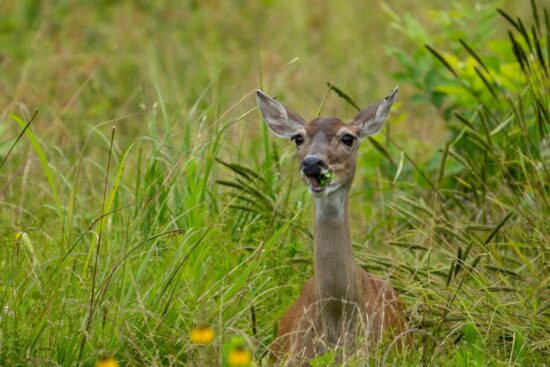What if you woke up on a beautiful spring morning, ready to enjoy your gorgeous rose garden, only to find bare stems where stunning blooms used to be?
If you’ve ever wondered whether deer eat roses, you’ve come to the right place. This guide will help you understand why deer consider eating roses and, more importantly, how to protect your precious plants.
Do Deer Eat Roses?
Let’s get straight to the point: deer will eat the buds, blooms, foliage, and even the thorny canes of rose bushes. Nothing on your rose bush is safe from hungry deer. Deer are especially fond of the new, tender growth where the thorns are not so sharp and firm yet. Think of it this way: deer look at roses like many of us do fine chocolates. They simply can’t resist them, thorns and all.
What Parts Do Deer Eat?
Deer aren’t picky eaters when it comes to roses. They’ll munch on buds and blooms, which is the most heartbreaking loss for gardeners. Deer love the sweet taste and soft texture of rose flowers and buds. They’ll also eat leaves and foliage since the tender green leaves provide good nutrition and are easy to digest. Even the thorny stems and canes aren’t off limits, though deer will tend to leave the branches alone and focus on flowers and leaves in most cases. New growth is like deer candy because young shoots are tender, less thorny, and full of nutrients.
How Much Damage Can They Do?
The numbers might shock you. Each deer eats, on average, 5 to 15 pounds of plant material taken from shrubs and trees each day. Even worse, when deer generally live and feed in herds, they can do an astounding amount of damage to gardens, roses included, in a short amount of time.
Deer damage can occur mostly at night, as deer are less likely to browse during the day. This means you might go to bed with a beautiful rose garden and wake up to find it completely stripped.
Why Deer Love Roses So Much
Understanding why deer are attracted to roses can help you protect your garden better. Roses aren’t just pretty – they’re packed with nutrients that deer need. Deer are attracted to roses for their high sugar content, which provides a natural source of energy, especially when they need extra energy. Roses also provide deer with calcium for bone, teeth, and antler growth, vitamin C for immune system function, and other essential nutrients.
Since roses are part of the Rosaceae family, which also includes fruits like apples and cherries, they’re naturally appealing to deer who love eating fruit. Your well-maintained rose garden might be too tempting for deer to resist. Deer are attracted to well watered, well fertilized plants with a lot of tender growth, and roses fit that bill perfectly. A rose’s fragrance is one of the primary reasons why deer are so attracted to roses. The stronger the scent, the more appealing your roses become.
How to Spot Deer Damage
Knowing what to look for can help you identify deer damage quickly. Look for these telltale signs:
- Chewed leaves with jagged edges and partially eaten foliage
- Missing buds and flowers where deer cleanly nip off buds at the bottom
- Broken canes that give the plant a weird, uneven shape
- Heart-shaped hoof prints around your garden beds
Deer usually do their browsing damage at night and occasionally you may see deer eating roses during the day. If you notice fresh damage in the morning, deer were likely the culprits. The damage often appears systematic, with entire sections eaten methodically rather than random nibbling.
Rose Varieties: Which Ones Are Most at Risk?
Not all roses are equally appealing to deer, but unfortunately, most popular varieties are like candy to them.
Most Vulnerable Types
Standard roses such as drift roses, knockout roses, miniature roses, hybrid tea roses and David Austin shrub roses are favorite deer dinner treats. These popular garden varieties are exactly what deer love most because they’re well-bred, tender, and often very fragrant.
Deer-Resistant Options
The good news is that some roses are naturally more resistant to deer. Rugosa roses are your best bet for deer resistance. These roses are pretty thorny, much more thorny than any other roses and highly fragrant. Even without deterrent sprays, deer still won’t touch rugosa roses. Popular rugosa varieties include:
- ‘Blanc Double de Coubert’ with white flowers
- ‘Hansa’ with deep purple-red blooms
- ‘Thérèse Bugnet’ with pink flowers
- ‘Agnes’ with yellow blooms
You should also consider native species like pasture rose, Virginia rose, and swamp rose because they are more resistant to deer. The few plants that deer won’t touch basically narrow down to three categories: highly scented, poisonous, and the very thorny. Rugosa roses check both the scented and thorny boxes, making them naturally deer-resistant.
Physical Protection Methods
Sometimes the best defense is a good fence. When it comes to fencing solutions, height matters most. Fencing should be at least 8 feet tall, with mesh openings no larger than 2 inches. This ensures deer cannot jump over or squeeze through. Electric fencing can be very effective, though it requires more setup and maintenance.
The Fishing Line Trick
For a less visible option, you can string high-test 30-pound or heavier monofilament fishing line tightly around a garden bed at least two feet beyond the outside edge and 36 inches above the ground. Deer encounter the fishing line in the dark making them feel uncomfortable and then avoid the area.
For individual plant protection, wire cylinders can be placed seasonally around individual trees and shrubs to physically exclude and prevent deer from browsing. Netting is a more cost-effective option but requires regular maintenance to prevent tangling. Deer are less likely to browse on plants that are elevated or difficult to access, so raised beds can provide natural protection.
Repellent Strategies That Actually Work
Repellents can be your first line of defense against deer. Commercial spray applications like Liquid Fence, Deer Scram, and Bobbex have shown good results. These sprays emit a foul taste and odor that deter deer. You will want to begin spraying in the spring and continue weekly through September. You may also need to reapply these repellents from time to time, particularly after it rains.
DIY Repellent Recipes
- Plant-based peppermint oil formula repels pests naturally
- Safe to use around pets, kids, and indoor living spaces
- Great for garages, attics, baseboards, and outdoor areas
- Fresh mint scent with long-lasting protection
You can save money and make your own effective deer repellents at home:
Egg-based spray: Put eggs, milk or yogurt, garlic, and cayenne pepper along with two to three cups of water into a blender, and puree thoroughly. Mix with a gallon of water and spray on plants.
Soap solution: Grate a bar of soap (Ivory works well) into water, add crushed garlic cloves and pepper flakes, bring to a simmer, then strain and dilute before spraying.
Vinegar mixture: Add 8 ounces of white vinegar to a spray bottle with 6 drops of peppermint essential oil and 4 drops of rosemary essential oil.
Natural Scent Deterrents
Scent deterrents work well because deer are averse to strong fragrances. Deer dislike fragrant soaps like Irish Spring, Ivory, and Lifebuoy. Shred the soap into tiny pieces, put in mesh bags, and tie to trees or plants you want to protect. Human hair carries the scent of humans, which can deter deer from approaching an area. Collect hair clippings from a hair salon and place in mesh bags or old pantyhose around your garden.
High-Tech Deterrents
No products found.
Modern technology can help protect your roses through motion-activated devices. Deer sprinklers use a spray of water to scare deer away from your roses. Deer hate being surprised by water, so automatic, motion-sensor sprinklers help deter them effectively. Ultrasonic repellers work by broadcasting specific frequencies that are bothersome to deer. Wind chimes, radios, or other sound-making devices can also startle deer and keep them away.
Visual Tricks That Work
Visual deterrents can be surprisingly effective. Reflective items like old CDs, shiny ribbons, or other metallic objects can scare deer away. The movement and light reflection confuse and frighten deer. Flags, streamers, and pinwheels create motion that deer find unsettling and will often cause them to avoid the area entirely.
Smart Garden Design
Your garden layout can be a powerful tool in deer prevention. Deer are very sensitive to smell, taste and textures, and herbs have all of those qualities that deer dislike.
Companion Planting
Some deer resistant herbs are Rosemary, Sage, Bee Balm, Lavender, Basil, Oregano, and Chives. Plant these around your roses to create natural barriers. Other deer proof plants are Bleeding Hearts, Astilbe, Marigolds, Butterfly Bush, and Coreopsis.
Plant highly desirable plants in areas with more human activity, and utilize more deer resistant plants near garden edges where deer are more likely to enter. Create barriers using thorny or aromatic plants as natural fences around your roses. Combine multiple deterrent methods for better results, and make sure you can easily reach your roses for maintenance and repellent application.
Seasonal Protection Strategies
Spring is the most critical time for rose protection. In the spring when the first bit of green appears, begin a weekly spray schedule. Seasonal feeding habits peak in spring and summer, coinciding with the time when rose buds and blooms are most susceptible to deer damage.
Spring Setup
Begin repellent applications as soon as you see new growth, maintain a weekly schedule for consistency during this vulnerable period, and pay extra attention to tender new shoots.
Summer and Fall Adjustments
During summer, implementing effective wildlife deterrents is essential for rose protection. Continue your vigilant approach and reapply repellents after rain or heavy watering. Give extra care during peak flowering season when roses are most attractive to deer.
In fall and winter, many gardeners change their approach. Some stop spraying in the first week of September, allowing deer to show up and begin eating. They actually use this as natural winter pruning. However, during the winter when food is scarce, deer may become more desperate and venture closer to your roses.
What to Do When Deer Strike
Even with the best protection, deer might still damage your roses. When this happens, there is little one can do once roses have been munched on by hungry deer except prune down what is left of the damaged canes.
Recovery Steps
- Assess the damage first, then focus on clean pruning
- Prune damaged canes just below the munched off part
- Cut at a 45 degree angle and use clean shears washed in bleach
- Seal all cut ends to prevent further damage and disease
For recovery support, watering the rose bushes with a water and Super Thrive mix will go a long way in helping the roses recover from the major stress of such an attack. As the rose recovers, refrain from applying large amounts of fertilizer as the shrub is in stress. Be patient with the recovery process because in most cases your rose will begin to flourish again in no time.
Common Mistakes to Avoid
Learn from others’ mistakes to protect your roses more effectively. Many gardeners rely too heavily on thorns as a deterrent, but deer are less likely to eat the greenery of a rose bush if it has thorns only when they have other food options. If they are hungry enough, they will try their best to eat as much as they can even if that means getting scraped by the thorns.
The Biggest Mistake
Another common mistake is using a single method strategy. Deer can easily get used to one method of deer proofing, so it is best to rotate tricks for ongoing protection. Inconsistent application is another problem. Skipping spray schedules or forgetting to reapply after rain reduces effectiveness significantly.
It’s important to have realistic expectations about deer control. If the deer are hungry enough they will eat any plants they can get their teeth into. The bar soap method did seem to be effective for a while, then the deer seemed to get used to it. All protection methods require ongoing attention and care, so be prepared for the maintenance commitment.
Success Stories and Expert Tips
Professional advice consistently emphasizes that rotation is key. You should consider using deer deterrents and rotating between two and three repellents to ensure that they don’t get too comfortable with the scent or taste. A combination of physical barriers, chemical repellents, and landscape modifications can help mitigate deer-related problems.
Real Garden Success
One Oregon gardener found success with a simple approach: Start spraying in spring when the first bit of green appears with a weekly spray schedule, then stop spraying in September. This method protected 150 rose bushes in deer-heavy territory. Another gardener reported success with motion-activated sprinklers, noting that the deer scamper off when the sprinkler comes on.
Your Action Plan
Start protecting your roses today by first assessing your situation. Evaluate current deer pressure in your area, identify which roses are most vulnerable, and note when damage typically occurs. Next, choose your methods based on your budget and maintenance ability. Start with one or two approaches and plan for seasonal adjustments.
Getting Started
- Begin early in the growing season
- Apply repellents consistently
- Monitor effectiveness regularly
- Rotate deterrent methods every few months
Finally, adapt and improve your approach. Adjust strategies based on results, and stay persistent and patient throughout the process.
Closing Thoughts
Yes, deer absolutely eat roses, and they can cause significant damage to your garden. However, with the right combination of strategies, you can protect your roses and enjoy their beauty throughout the growing season. Start early by beginning protection before damage occurs, not after. Use multiple methods by combining physical barriers, repellents, and smart planting for best results. Stay consistent because regular maintenance and application are crucial for success.
Be patient because finding the right combination of methods for your specific situation may take time. Adapt as needed since deer behavior can change, so be ready to adjust your approach. Don’t let deer discourage you from growing roses. With proper protection and care, you can have the beautiful rose garden you’ve always wanted.
The key is understanding that deer protection is an ongoing process, not a one-time fix. Stay vigilant, be consistent, and soon you’ll be enjoying gorgeous roses while the deer look elsewhere for their next meal. Your roses are worth the effort, and with these proven strategies, you can keep them safe from hungry deer while maintaining a beautiful, thriving garden that brings joy for years to come.



